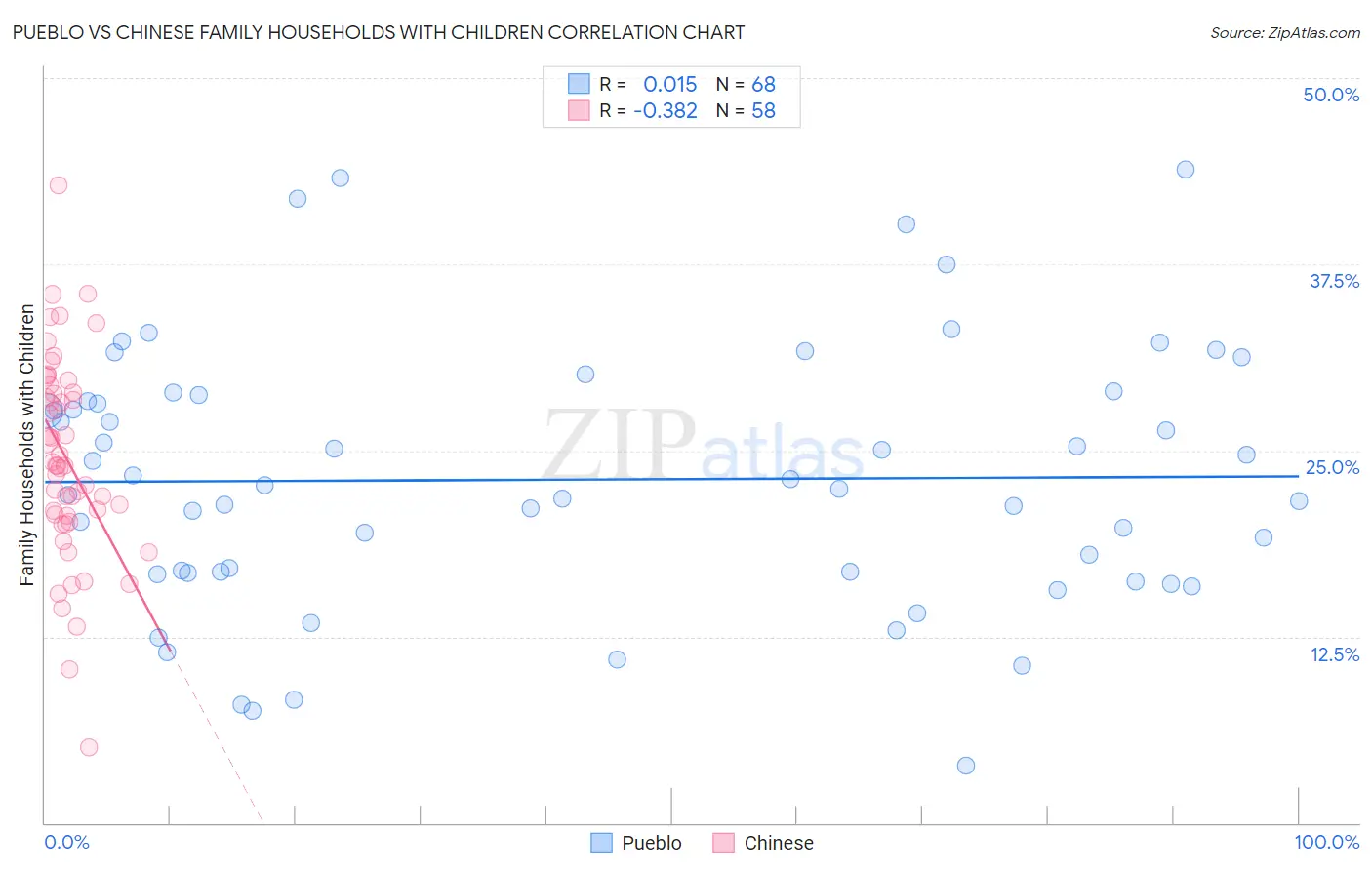Pueblo vs Chinese Family Households with Children
COMPARE
Pueblo
Chinese
Family Households with Children
Family Households with Children Comparison
Pueblo
Chinese
25.2%
FAMILY HOUSEHOLDS WITH CHILDREN
0.0/ 100
METRIC RATING
344th/ 347
METRIC RANK
26.0%
FAMILY HOUSEHOLDS WITH CHILDREN
0.0/ 100
METRIC RATING
324th/ 347
METRIC RANK
Pueblo vs Chinese Family Households with Children Correlation Chart
The statistical analysis conducted on geographies consisting of 120,047,351 people shows no correlation between the proportion of Pueblo and percentage of family households with children in the United States with a correlation coefficient (R) of 0.015 and weighted average of 25.2%. Similarly, the statistical analysis conducted on geographies consisting of 64,800,060 people shows a mild negative correlation between the proportion of Chinese and percentage of family households with children in the United States with a correlation coefficient (R) of -0.382 and weighted average of 26.0%, a difference of 3.1%.

Family Households with Children Correlation Summary
| Measurement | Pueblo | Chinese |
| Minimum | 3.8% | 5.1% |
| Maximum | 43.8% | 42.8% |
| Range | 40.0% | 37.7% |
| Mean | 23.0% | 24.4% |
| Median | 22.5% | 24.0% |
| Interquartile 25% (IQ1) | 16.8% | 20.6% |
| Interquartile 75% (IQ3) | 28.5% | 28.8% |
| Interquartile Range (IQR) | 11.7% | 8.2% |
| Standard Deviation (Sample) | 8.7% | 6.8% |
| Standard Deviation (Population) | 8.7% | 6.7% |
Demographics Similar to Pueblo and Chinese by Family Households with Children
In terms of family households with children, the demographic groups most similar to Pueblo are Hopi (25.2%, a difference of 0.11%), Alsatian (25.3%, a difference of 0.26%), Immigrants from Serbia (25.5%, a difference of 0.94%), Immigrants from Armenia (25.6%, a difference of 1.3%), and Immigrants from St. Vincent and the Grenadines (25.6%, a difference of 1.4%). Similarly, the demographic groups most similar to Chinese are Barbadian (26.0%, a difference of 0.060%), Immigrants from Ireland (26.0%, a difference of 0.080%), Immigrants from Barbados (26.0%, a difference of 0.19%), Immigrants from Albania (25.9%, a difference of 0.29%), and Cypriot (25.9%, a difference of 0.42%).
| Demographics | Rating | Rank | Family Households with Children |
| Chinese | 0.0 /100 | #324 | Tragic 26.0% |
| Barbadians | 0.0 /100 | #325 | Tragic 26.0% |
| Immigrants | Ireland | 0.0 /100 | #326 | Tragic 26.0% |
| Immigrants | Barbados | 0.0 /100 | #327 | Tragic 26.0% |
| Immigrants | Albania | 0.0 /100 | #328 | Tragic 25.9% |
| Cypriots | 0.0 /100 | #329 | Tragic 25.9% |
| Immigrants | Latvia | 0.0 /100 | #330 | Tragic 25.9% |
| Slovenes | 0.0 /100 | #331 | Tragic 25.8% |
| Immigrants | Austria | 0.0 /100 | #332 | Tragic 25.8% |
| Immigrants | Switzerland | 0.0 /100 | #333 | Tragic 25.7% |
| Slovaks | 0.0 /100 | #334 | Tragic 25.7% |
| Immigrants | Croatia | 0.0 /100 | #335 | Tragic 25.7% |
| Immigrants | West Indies | 0.0 /100 | #336 | Tragic 25.7% |
| Puerto Ricans | 0.0 /100 | #337 | Tragic 25.6% |
| Arapaho | 0.0 /100 | #338 | Tragic 25.6% |
| Immigrants | St. Vincent and the Grenadines | 0.0 /100 | #339 | Tragic 25.6% |
| Immigrants | Armenia | 0.0 /100 | #340 | Tragic 25.6% |
| Immigrants | Serbia | 0.0 /100 | #341 | Tragic 25.5% |
| Alsatians | 0.0 /100 | #342 | Tragic 25.3% |
| Hopi | 0.0 /100 | #343 | Tragic 25.2% |
| Pueblo | 0.0 /100 | #344 | Tragic 25.2% |